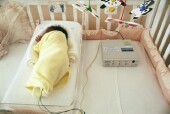

URL of this page: http://www.nlm.nih.gov/medlineplus/news/fullstory_69140.html (*this news item will not be available after 12/10/2008)

 WEDNESDAY, Sept. 10 (HealthDay News) -- Bacterial infections may be an overlooked cause of sudden infant death syndrome (SIDS), an Australian study suggests.
WEDNESDAY, Sept. 10 (HealthDay News) -- Bacterial infections may be an overlooked cause of sudden infant death syndrome (SIDS), an Australian study suggests.
The research examined post-mortem reports on 130 babies who died of SIDS, 32 who died suddenly as a result of infection, and 33 who died of non-infectious causes.
This was followed by an analysis of bacterial isolates from normally sterile sites (such as heart blood, spleen, or cerebrospinal fluid) in all the babies. Infection at a sterile site was rare in the babies who died of non-infectious causes but was present in 20 percent of the babies with sudden infection and 10 percent of the SIDS babies.
The infections were caused by Staphylococcus aureus, a dangerous bacteria that can produce potentially deadly toxins.
In a living person, confirmation of sterile site infection is a marker of systemic infection. But this type of finding in an infant who's died of SIDS is attributed to contamination and often dismissed as a cause of death, the researcher said.
However, the relatively high proportion of SIDS babies in this study who had S. aureus in sterile sites suggests that a number of them died due to the infection, the researcher concluded.
The study was published online ahead of print in the Archives of Disease in Childhood.
Previous research has suggested that immune responses to bacterial infections or toxins can cause a "chemical storm" in infants that result in sudden death. The study author said the cause of death may need to be reconsidered in cases of SIDS where S. aureus is found in sterile sites.
Related MedlinePlus Pages:
Date last updated: 12 September 2008